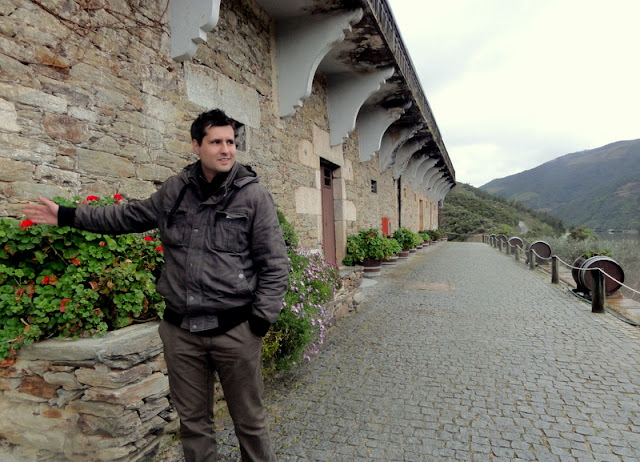
A little while ago I finally test rode an
ANT Truss Bicycle for the first time, and the memory now seems like a dream. I cannot describe how much I love this frame design, specifically as executed by
ANT. I have a separate post about truss frames, so I won't go into it again here. But something about that truss, in combination with the double plated fork crown, just "hits the spot" for me visually, and I've fantasised about riding one more times than I care to admit.

Luckily, I know Jim A. - a great mechanic at
Harris Cyclery - who owns a glorious truss frame
ANT, which I was able to ride. In retrospect, I can just kick myself for not taking the pictures before lowering the saddle, because the bike looks better with more seatpost showing. But in my excitement I was not thinking clearly and I hope you can overlook this aesthetic blunder.

Jim's
ANT was built in 2007. It is a 53cm frame with 700C wheels, built for fixed gear.

The paint is liquid coat and the colour is a shade of dark cherry that appears to drip seductively as it catches the light.

Photographing this part felt a little wrong, but I decided an invasion of privacy was in order here to show the full darlingness of this sexy creature.

As I've written before, the truss frame is one design that I actually
prefer to be TIG-welded (or fillet-brazed) as opposed to lugged, because lugs - to my eye - would look too busy here. The key for me is that these welds to be cleanly done, and this frame does not disappoint in that respect.

Jim A. set up this bicycle very similarly to the way I would have done. The upside-down
Nitto Albatross handlebars strike the perfect balance between aggressive positioning and comfort. The single front caliper brake and the fixed gear rear wheel are uncluttered, simple to operate, and in keeping with a vintage look. I would put the brake lever on the right handlebar, but otherwise would set everything up just the same.

The copper rails and rivets on this
Brooks B17 complement the frame beautifully. Those are Jim's initials carved into the toptube, in case you spotted them.

Rear brake(less) bridge. Though I have seen some truss frame bicycles equipped with fenders, racks and all sorts of extras, I think it looks best without - pathracer style.

The
Sugino 75 is a really nice track crankset that the Co-Habitant thinks I ought to get, should I ever upgrade my fixed gear roadbike. Truthfully, I kind of don't get what the big deal is with this particular crankset, but sure - it looks nice enough.

These
Pauldropouts are beyond "nice" though: I'm afraid I will salivate if I look at these for too long. Mmmm!

I wasn't especially attracted to
Phil hubs until I saw this on Jim's bike. Gosh, this just looks so perfect.

And from another angle...

I rode Jim's truss bike briefly and slowly - It was in such perfect condition, that I was scared to death to let anything happen to it. Sadly, there was no one around to photograph me, as Jim was working and the Co-Habitant was busy buying components. But just imagine me looking both ecstatic and terrified as I pedaled this graceful machine along West Newton side streets, past pensioners and mothers with baby carriages... Of course they all wanted to ride it. As their eyes followed the glistening
Phil hubs with longing and admiration, I felt like the luckiest girl in town.

I don't know how useful it is to review a custom-built bicycle, and one ANT truss frame may not necessarily feel or handle like another. But in case you are curious...

The first thing I noted, was that the bicycle felt significantly lighter than I expected it to. I guess because of the truss construction, I assumed that it would be on the heavier, clunkier side - more like a roadster. But this truss was whippet-sleek, lightweight, elegant and compact.

I got on and was surprised at how far forward I had to lean in order to reach the handlebars - Jim must have used a long stem to compensate for the swept-back Albatross bars. The aggressive posture made it easy to accelerate once I began riding and to go faster than I had intended.It was at this point that I realised how unaccustomed I'd gotten to riding fixed gear without foot retention, and also to the brake being mounted on the left. Thankfully, I figured it out in time to stop for the next red light - but after that I slowed down and was more careful. The ride was comfortable - nothing hurt and there was no excessive strain or pressure on any part of my body.For a bicycle with 28mm tires, it did not feel harsh over bumps. It felt stable, but then I tend to feel more stable on fixed gear bikes in general, so I don't know how telling that feedback is.Having never ridden a vintage pathracer, I cannot compare it to one - but I am fairly certain that the geometry of the
ANT truss frame is modern and does not emulate actual vintage pathracers. If I had to categorise the handling, more than anything it felt like a light and fast "casual" bicycle for those who are used to roadbikes but want something a bit gentler and more upright for Sunday afternoon rides with friends.

While some might question the practicality of a vintage-styled pathracer in an era when racing is done with dropbars and commuting is done with fenders and racks, I think that's beside the point. The classic truss frame pathracer is an idealised examplar of what
ANT can create, and I find that appealing. Not all bicycles need to be versatile and practical in every respect.When I get my
ANT, it will be almost exactly like this one - just because I want to support and celebrate what I believe to be Mike Flanigan's craftsmanship at its best.

Though I only managed to take this shabby picture of Jim A. with his bike, some day I will meet him outside of work and take a nicer portrait. Until then, I thank him for entrusting me with his Truss. This is truly one of my favourite bicycles.
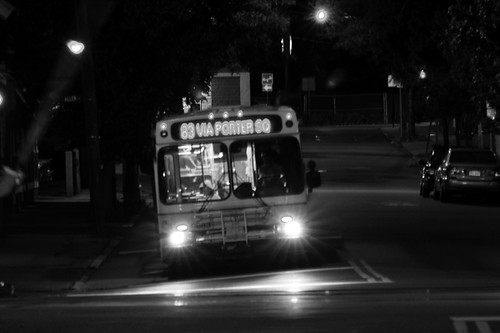 As a cyclist, I doubt that I am alone in my strong dislike of city buses. They are enormous. They make frequent stops and wide turns. They have sizable blind spots. And their operators - overwhelmed with countless stimuli and the stress of keeping to a schedule - don't always notice cyclists in their path. All in all, it seems reasonable to be wary of these vehicles, and prudent to keep away from them whenever possible.
As a cyclist, I doubt that I am alone in my strong dislike of city buses. They are enormous. They make frequent stops and wide turns. They have sizable blind spots. And their operators - overwhelmed with countless stimuli and the stress of keeping to a schedule - don't always notice cyclists in their path. All in all, it seems reasonable to be wary of these vehicles, and prudent to keep away from them whenever possible.
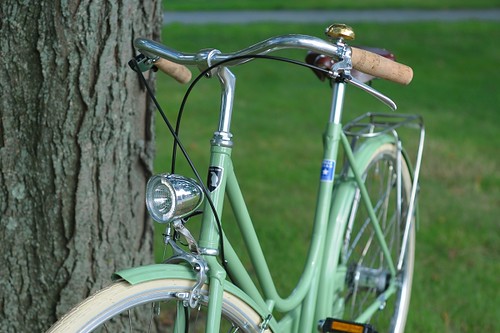 Fashionably late and appropriately glamorous, the Bella Ciao Superba is here! I was nervous up till the moment I saw it, but the bicycle is perfect. The pre-ordered bikes should be off to their owners very soon.
Fashionably late and appropriately glamorous, the Bella Ciao Superba is here! I was nervous up till the moment I saw it, but the bicycle is perfect. The pre-ordered bikes should be off to their owners very soon.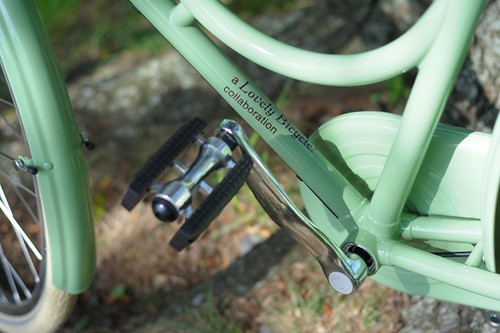 To recap for new readers, this is the result of a collaboration between myself and Bella Ciao, and you can read about it here and here. Twelve bikes were made as a special edition and they are available exclusively at Harris Cylery in West Newton, MA. I know that a good portion of them have already been sold, so please check with Harris for availability. The price is $1,495. I am not the one selling the bicycles (and I do not receive commission on the ones sold), so please contact Harris directly with all sales inquiries.
To recap for new readers, this is the result of a collaboration between myself and Bella Ciao, and you can read about it here and here. Twelve bikes were made as a special edition and they are available exclusively at Harris Cylery in West Newton, MA. I know that a good portion of them have already been sold, so please check with Harris for availability. The price is $1,495. I am not the one selling the bicycles (and I do not receive commission on the ones sold), so please contact Harris directly with all sales inquiries. The Bella CiaoSuperba frames were handmade in Italy, using Columbus Thron tubing. The frame size is 54cm, with 700C wheels. Tires are the cream Schwalbe Delta Cruisers, 700Cx35mm. The wheelsets are proprietary to Bella Ciao, made inhouse.
The Bella CiaoSuperba frames were handmade in Italy, using Columbus Thron tubing. The frame size is 54cm, with 700C wheels. Tires are the cream Schwalbe Delta Cruisers, 700Cx35mm. The wheelsets are proprietary to Bella Ciao, made inhouse.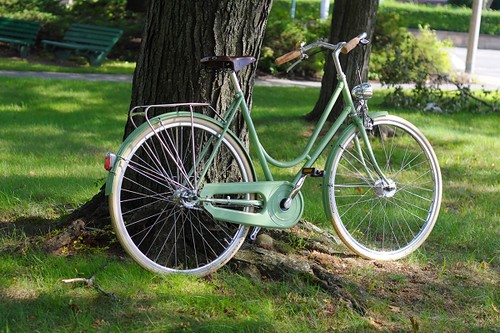 The Superba includes all the components and accessories pictured here, which I will detail below. It is a 3-speed bicycle with a rear coaster brake and front handbrake, internally routed dynamo lighting front and rear, leather Brookssaddle, natural cork grips, chaincase, and a handmade rear rack.
The Superba includes all the components and accessories pictured here, which I will detail below. It is a 3-speed bicycle with a rear coaster brake and front handbrake, internally routed dynamo lighting front and rear, leather Brookssaddle, natural cork grips, chaincase, and a handmade rear rack.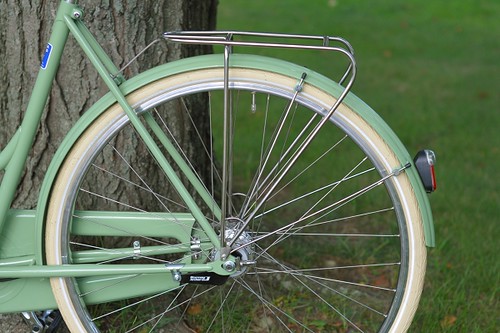 The stainless steel racks were designed by me and handmade in Dorcester, Massachusetts by Trimount Ironworks. They are rated to carry 18kg (40lb) of weight, provide attachment for bungee cords, and will accommodate a variety of pannier systems.
The stainless steel racks were designed by me and handmade in Dorcester, Massachusetts by Trimount Ironworks. They are rated to carry 18kg (40lb) of weight, provide attachment for bungee cords, and will accommodate a variety of pannier systems.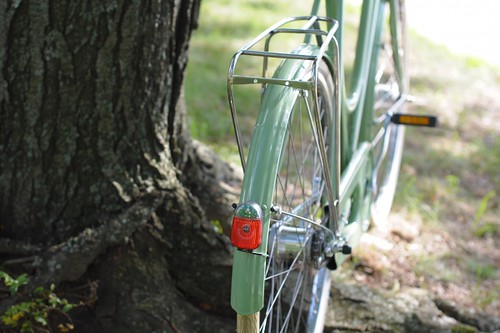 There is a provision for attaching a battery-operated tail light to the rack, for those who wish to supplement the dynamo lighting.
There is a provision for attaching a battery-operated tail light to the rack, for those who wish to supplement the dynamo lighting.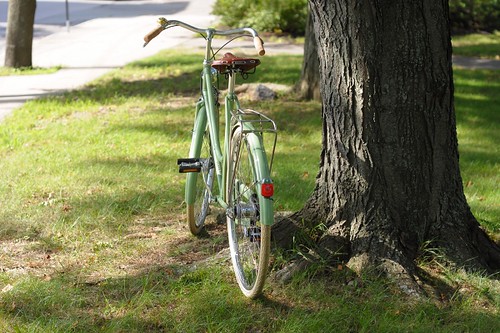 One thing I like about the stainless rack with its thin tubing, is that it has the effect of being "invisible" on the bike. I've played around with a number of different racks, and this definitely suits the bicycle best. I may write a separate post about the rack design in the near future.
One thing I like about the stainless rack with its thin tubing, is that it has the effect of being "invisible" on the bike. I've played around with a number of different racks, and this definitely suits the bicycle best. I may write a separate post about the rack design in the near future.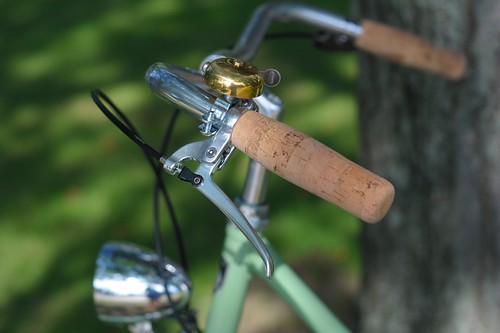 The high-polished alloy handlebars are made by Bella Ciao. I would describe them as a hybrid between North Road and Porteur style bars, and they are possibly my favourite handlebars on the market today.
The high-polished alloy handlebars are made by Bella Ciao. I would describe them as a hybrid between North Road and Porteur style bars, and they are possibly my favourite handlebars on the market today. 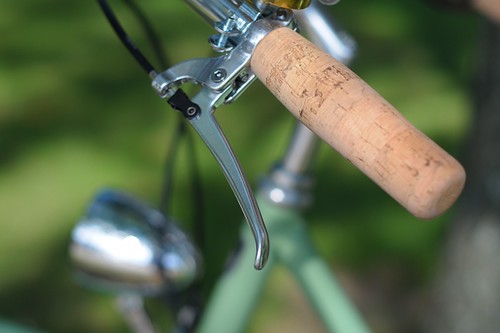 The bike is fitted with natural Portuguese cork grips from Rivendell and elegant Tektro city brake levers. The cork grips will be left unfinished, but they can be shellacked by the owner - which will make them darker. The brake lever can be placed either on the right or on the left.
The bike is fitted with natural Portuguese cork grips from Rivendell and elegant Tektro city brake levers. The cork grips will be left unfinished, but they can be shellacked by the owner - which will make them darker. The brake lever can be placed either on the right or on the left.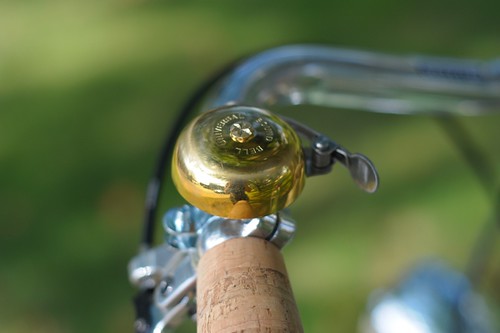 Brass bell, of course.
Brass bell, of course.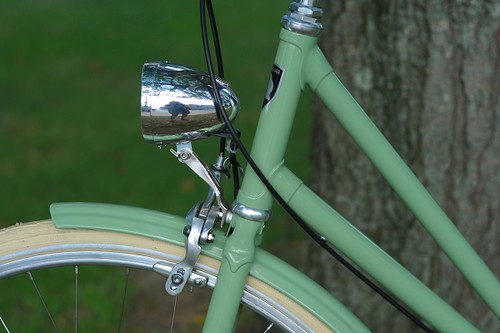 The dynamo-powered lighting is by the German manufacturer Buechel.
The dynamo-powered lighting is by the German manufacturer Buechel.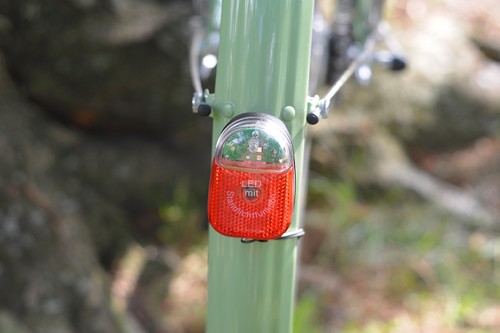 It looks fairly classic and unobtrusive, and works nicely.
It looks fairly classic and unobtrusive, and works nicely.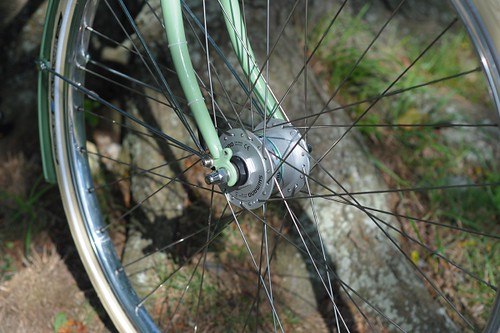 The dynamo hub is Shimano. The wiring is routed externally up the fork, then internally through the frame, exiting through one of the chainstays.
The dynamo hub is Shimano. The wiring is routed externally up the fork, then internally through the frame, exiting through one of the chainstays.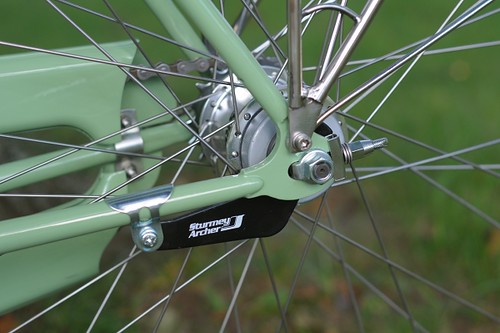 Sturmey Archer3-speed coaster brake hub.
Sturmey Archer3-speed coaster brake hub.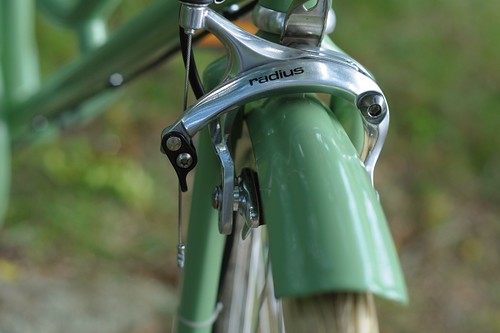 Front caliper brake.
Front caliper brake.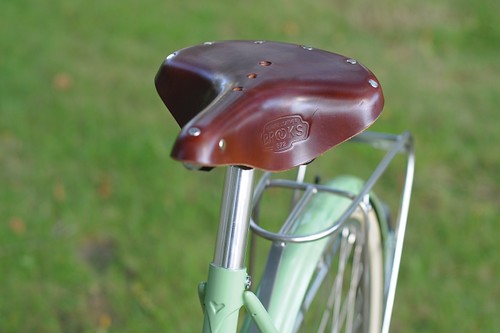 Brown Brooks B72 saddle.
Brown Brooks B72 saddle.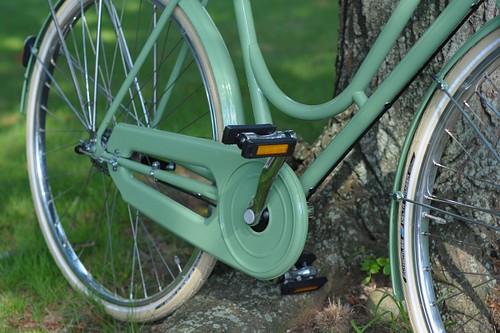 Non-slip platform pedals.
Non-slip platform pedals.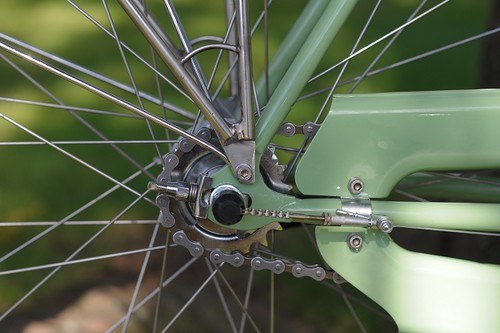 And the fork ends/dropouts (I like to remove those black dust caps, but forgot to do it here). You can also see the bungee cord attachment point on the rack here.
And the fork ends/dropouts (I like to remove those black dust caps, but forgot to do it here). You can also see the bungee cord attachment point on the rack here.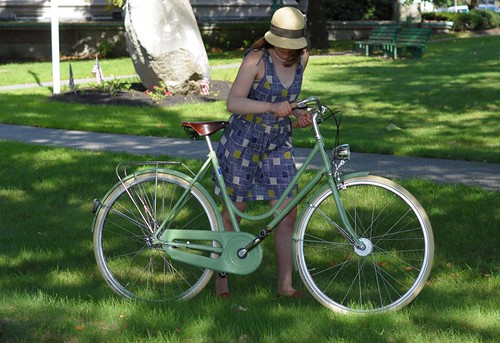 The colour of the bike as it shows up in the pictures here is fairly accurate. It is not the same colour as my own bike, but a more vibrant, saturated pastel green. If you have any questions about the features, I will be glad to answer them here. I hope that the owners of these bicycles will be pleased with them - I am very happy with how they came out. There is some talk of more bikes, but nothing is certain yet - so your thoughts are welcome. Many thanks to Bella Ciao again for the opportunity to work on this project, and many thanks to Harris Cycley for all of their help.
The colour of the bike as it shows up in the pictures here is fairly accurate. It is not the same colour as my own bike, but a more vibrant, saturated pastel green. If you have any questions about the features, I will be glad to answer them here. I hope that the owners of these bicycles will be pleased with them - I am very happy with how they came out. There is some talk of more bikes, but nothing is certain yet - so your thoughts are welcome. Many thanks to Bella Ciao again for the opportunity to work on this project, and many thanks to Harris Cycley for all of their help.































